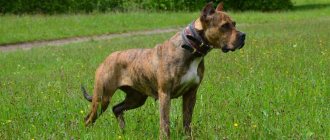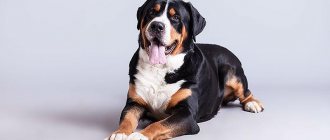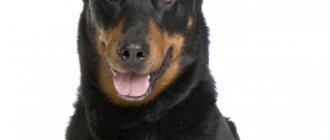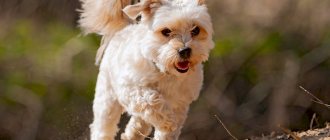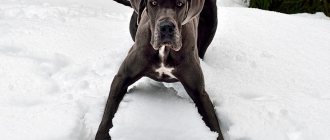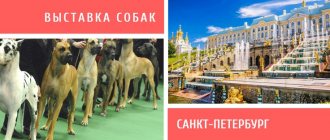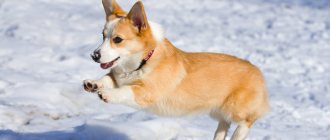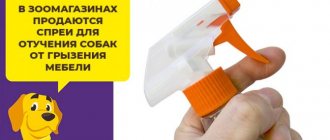Interesting facts about the Alanian fighting dog
It is noteworthy that in ancient times few Alanos were allowed to breed. The dogs were shown a bull, and if they began to rush at it, then the animal was considered suitable for breeding.
When grazing, Alanos can detain a cow or bull only by biting the animal’s ears or neck. They are taught this from childhood, because their ears heal quickly, and you can bend a cow by the neck without running into sharp horns.
Where to buy
Today in our country there are no official kennels of the Alanian Great Dane. You can get a puppy from abroad: Spain, USA. The price for a representative of the breed starts at $1,000. The cost depends on the class of the dog and its suitability for breeding. In advertisements for sale you can often find offers of puppies of this rare breed for a modest price. There is no need to succumb to temptation - only a few representatives of the breed are officially known in our country, and their offspring cannot be cheap.
In the modern world, the Alanian Dog has replaced its formidable specialization as a fighting dog for the role of a companion and guard. In this capacity, the animal shows itself only from its best side. But, it is necessary to remember that in order for a dog to be a devoted friend and faithfully serve its owner, it requires a lot of effort and time.
History of the breed
The exact time of the appearance of the Alano dog breed cannot be determined, which is explained by their ancient history. According to some sources, in Spain, even during the reign of the Romans, large war dogs were set against bulls.
Throughout its existence, the Alan Dogo accompanied the Spanish warriors. Dogs helped soldiers in battle, on the road, and took part in cruel entertainment.
This is interesting! For a long time, mainly Alans took part in dog fights.
However, by the beginning of the twentieth century, this bloody event was banned, and its organizers began to be persecuted. At the same time, civil war broke out in Spain, and as a result, fighting dogs practically became extinct, as the people lost interest in them.
Revival of the breed
Only towards the end of the twentieth century, caring dog breeders organized a search for the remaining individuals and began to take measures to restore the population.
It was possible to find fifty representatives of this breed and, on their basis, it was possible to derive about a dozen pedigree lines. Preference was given to working qualities rather than external ones.
Now the Alan dog is the ancestor of many other breeds, and the Alanos themselves number about a thousand individuals. Russia accounts for only a few dozen.
Read also:
Assyrian dog
Sarmatian fighting dogs
Sources:
A. Kochiev Dog of Alans or fighting dogs of the past
Slanov A.A. Military affairs Alan I-XV centuries.
The Alan Bulldog or Spanish Bulldog is an ancient breed that has recently become popular not only in Spain. Huge dogs became famous for their courageous character and swiftness, combined with obedience and poise.
- Alano Espanyol
- Alano Espanola puppy
- Adult Alano Hispaniol
The Alan War Dog is an aboriginal breed; it is considered the progenitor of almost all modern Molossians. Many dog breeders were surprised that the dog breed could be revived, since for a long time it was considered degenerate.
The content of the article
Appearance of the Alano dog breed
The Alan dog, as it is sometimes called, owes its popularity largely to its frightening and menacing appearance.
The description of the breed looks like this:
- males can be up to 62 cm at the withers, females a little lower - up to 58 cm;
- the animal's body is strong and muscular;
- the head is square, tightly set on a wide neck;
- eyes are small in size and may be yellow, brown or hazel in color;
- Above the slightly concave lower jaw is a wide, triangular nose.
Additional Information! Short ears are cropped during puppyhood.
Alan color
Representatives of the breed are usually brindle in color. It is largely thanks to him that the breed became so widely known. However, there are also grey, black, red, red or fawn dogs.
Dossier
Adult height: males - 65 ms, females - 61 cm. Weight: male - from 38 to 45 kg, female - 33-38 kg. Characteristic color: different shades of brindle. Coat Length: The coat is short and smooth to the touch. Life expectancy: from 10 to 13 years. Advantages of the breed: patient, balanced, not picky, intelligent. Difficulties of the breed: too independent. Average price: from $500 to $2800. Classification: medium breed; hunting, guard dog, companion dog.
Disqualifying defects and shortcomings
There are deviations from breed standards that are considered unacceptable. If the dog has any, the expert has the right to disqualify him. These vices include:
- blue or light eyes;
- undershot (more than 3-4 mm);
- poorly developed chest;
- small stature;
- cryptorchidism.
In addition to all of the above, a dog with serious behavioral abnormalities or a poor nervous system is not allowed to participate in the exhibition and breeding.
Character and psyche of the breed
Despite its bloody history and terrifying appearance, a healthy Alano dog has a calm and balanced temperament. She is not prone to displaying causeless aggression or excessive activity.
The dog has a healthy instinct to protect its territory and its family members. She is wary of strangers. In a family, the dog determines the leader and obeys only him. Other family members can count on attention and respect, but you should not expect unconditional obedience from the dog.
Owner reviews
A few reviews:
- “Our Arnold is just an amazing dog. Even our cat is not as affectionate as him. He loves everyone and is happy with everyone, but in case of danger he is ready to fight and defend the house. I always encourage everyone not to be afraid of a large dog. If you approach education correctly, then there is no risk for you.”
- “The dog is amazingly smart. When I return home tired and in a bad mood, he seems to feel it and approaches me very carefully, carefully and begins to caress me, as if he feels sorry for me.”
Raising and training the Spanish Alano
A serious and temperamental dog needs a strong leader who can lead. The tendency to dominate is present in the genes of all Alanos, so they should be raised from childhood.
The first commands can be taught from two months. Basic “sit”, “lie down”, “place”, “come to me”, “ugh!” must be mastered without fail so that the owner can apply them in everyday life. In addition to convenience in everyday life, learning commands provides the dog with the necessary mental stress, which allows the puppy to develop harmoniously.
When walking, you should not leave the Alan dog to its own devices. Walking only in the company of other dogs is also not recommended.
Important! Socialization is certainly a very important process, but in addition to communicating with dogs, the Alano must have strong contact with its owner. Therefore, during walks, it is necessary to repeat the learned commands and play with your pet.
Lifespan
Spanish Alano life expectancy
The Alano dog is distinguished by good health, it does not have a genetic predisposition to many Molosser diseases. The average life expectancy reaches 14-15 years, while the dog remains active and vigorous until the end. But animals require standard vaccination against most canine infections and protection against parasites. Among the diseases that can shorten the eyelid are hip dysplasia and inflammation of the middle ear.
Alano dog care and nutrition
The Alano's coat is short and does not require special care. Claws grow quickly and need to be trimmed regularly so that they do not cause discomfort to the animal when moving.
A dog needs many beneficial substances that it can only get from food. That is why the diet must be individually selected to suit the dog’s needs.
Nutrition for puppy and adult dog
Alanos accept dry food well. Provided that the food is chosen correctly and satisfies all the physiological needs of the dog, there will be no problems. For puppies, it is better to soak hard granules in water beforehand.
If we are talking about natural food, then the portion should include lean meat, dairy products, cereals and vegetables. If necessary, the diet is supplemented with vitamins.
Breeding Dogo Argentino
Breeding Dogo Argentinos is a very expensive proposition. If a dog breeder has enough money, you can safely get and breed representatives of this breed. The main task of the owner is to carefully select a partner for mating. If offspring are given to dogs that are related, there is a high probability of puppies being born with gene pathologies.
Dogs reach sexual maturity between 8 and 12-13 months of age. It is necessary to first agree with the owners of the partner for mating, clarify the status of the dog, the necessary information, life history, pedigree.
Dog handlers do not recommend allowing animals to breed immediately upon reaching puberty. Females are not ready to bear offspring at this age. The optimal mating age for females is 18-20 months, for males - 24 months. At this age, there is a more realistic chance of getting healthy, full-fledged offspring.
The owners of the female must keep a special diary in which the timing of estrus is noted. It is recommended to show both the male and female to the veterinarian 6-7 weeks before the planned mating. The doctor examines the animals and takes the necessary tests to assess readiness for reproduction.
Mating of animals is carried out on the territory of the male, preferably in the morning. After pregnancy has occurred, the owners of the female are recommended to give their pets more attention, love and care. During pregnancy, it is necessary to be observed by a veterinarian and provide a balanced diet rich in vitamins and minerals.
From one pregnancy, representatives of this breed give birth to 3 to 6 puppies. After the birth of the offspring, puppies should also be examined by a veterinarian.
Mating
As with many large breed dogs, the first heat in Spanish Alano bitches occurs at the age of one to one and a half years. But it is better not to breed a dog during its first heat, regardless of whether it is a female or a male. This can lead to the birth of sick offspring.
Dogs should not be bred earlier than 5-6 days after the start of estrus. It is best to organize mating on the territory of the dog, and introduce the dogs in a neutral zone. On her territory, a bitch can show aggression and drive away a representative of the other sex.
It is not recommended to interfere with the process, since animals are guided by instincts and can show aggression.
Possible diseases
Alanos need physical activity. A quiet lifestyle leads to the development of cardiovascular diseases. These are heart failure and cardiomyopathy. Heart problems are indicated by a blue tongue, wheezing, and intermittent breathing. The dog may lose consciousness. In this case, the animal must be immediately taken to a veterinary hospital. The only preventive measure is active walking. Running for a stick, jumping, playing with a ball will give the dog the opportunity to avoid diseases.
The scourge of large dog breeds is damage to the limbs. These include not only sprains and fractures. Spanish Alanos suffer from arthritis, bursitis and arthrosis. Diseases associated with the musculoskeletal system are expressed in limping. The animal's physical activity decreases. Preventive measures for such diseases include taking dietary supplements with chondroitin and glucosamine. When feeding homemade food, vitamins are needed in courses.
Important! Preparations for maintaining joint tissue are especially relevant during the growth period of puppies. Young animals are not recommended to take hurdles or carry heavy objects. Their workload is running and active games.
Large dogs, including Alanos, may have digestive problems. They suffer from bloating. The dog's belly increases in volume. The dog is breathing heavily and may groan. The condition occurs after eating and requires veterinary intervention. You won't be able to cure your pet on your own. If you notice this condition in a dog, you should immediately take it to the clinic for examination by a veterinarian. Sometimes the only way to help is surgery.
Illiterate breeders are to blame for the occurrence of the disease. The amount of food should be sufficient to ensure the dog’s vital functions, but it should not be overfed. You cannot feed the animal before a walk. Food intake should be provided 20–30 minutes after physical activity.
Choosing an Alano puppy
Purchasing a puppy from a kennel with a good reputation is a big advantage. This reduces the risk of buying a mongrel.
Puppies should be playful and moderately curious. If the baby hides in a corner and does not participate in the general fuss, most likely he has hereditary problems with the nervous system. It is difficult to predict the character of a future pet, so it is worth looking at its parents.
How much do they cost and where to buy
Since few people in Russia are breeding Alanos, it is best to purchase a puppy from foreign nurseries or from breeders who have been doing this for many years. The price of a puppy can vary from 20,000 to 30,000 rubles*.
In conclusion, it is worth noting that Alanos are good shepherds and guards. With proper training, they can become an excellent companion and a good family dog.
Briefly about the main thing
- Alano is an ancient breed of dog.
- The breed is not officially recognized by the FCI.
- Purpose: guard, hunting, shepherd.
- They can only live in a private home and require intense exercise.
- Alano breeding began in Russia - in Ossetia, the main nurseries - in Europe and the USA.
- The cost of dogs is from 500 to 1500 US dollars.
Share your experience of keeping representatives of this ancient breed in the comments. Your experience is very important and interesting.
Did you like the article? Share it with your friends on social media. networks. This will help them get useful information and support our project.
Description of the Alano breed
Alano or, as they are also called, Spanish bulldogs, are dogs of fairly large size, belonging to the Molosser breed. These dogs were bred by the Alan tribes, for which they acquired their name.
The tribes were engaged in breeding horses and livestock, but they were also excellent warriors. And they bred dogs that could participate in any battles. And so it happened that the Spanish Alano began to be used in bullfighting, where it gained enormous popularity.
However, in many cities they began to abandon bullfighting, which means that dogs were no longer needed. And the bullfight that remained was already done without fights between bulls and dogs. Then the man came up with dog fighting for his own entertainment, and again the strong, powerful and hardy Alanos came to the fore.
But fights soon began to be banned. They began to forget about the breed. And, perhaps, the magnificent, beautiful dog would have completely disappeared as a breed if the dog handlers had not sounded the alarm. It was only through their efforts that the Alano breed has survived to this day and is now just beginning to enjoy well-deserved interest. If you look at the photo of the Alano , you can find a lot in common with the American Staffordshire Terrier. They are indeed too similar, but still, they are completely different breeds.
According to the standard, the height of dogs of this breed should not be less than 45-50 cm at the withers, but weight is allowed only above 30 kg. The dog has a large head, powerful jaws, and ears, as a rule, are cropped. The dog's neck is powerful and strong. Well developed, wide, pumped chest, strong paws. The Spanish Alano coat , lying close to the croup. The color spectrum of wool is quite wide.
Behavior
Alano is a very friendly and affectionate dog, but only with those he knows. Strangers are alarming. Until the Alano studies them, he will not allow them to feel at ease. True, here it is enough to look at the size of the Spanish Alano (photos are presented in the article) to understand that you should not joke with him, especially when meeting him for the first time. In dealing with slow-witted people, the Alano acts decisively and swiftly.
At the same time, the dog clearly understands who is in front of him. He can decisively attack a thief or robber, but he will not touch simply passers-by who do not provoke him. For this valuable quality, they especially prefer to see him as a security guard. Such dogs hardly bark, but silently attack. They are best suited for houses with a high fence, where no one can accidentally get into in the absence of the owners.
If it did happen that the Alano attacked, then this could lead to the death of his opponent. He knows no pain and fear during an attack, his grip cannot be released without a command from the owner, and the size of the victim does not matter. That is why it is recommended to purchase a Spanish Bulldog only for the strongest people who can manage it correctly.
But for all their ferocity, they get along well with other animals in the same house.
According to history, Alanos have always been in packs with other dog breeds, but they have always been dominant. If other relatives showed intransigence, then everything was decided in a fight. An exception could be for the dogs raised with him.
The Spanish Alano can be described as an intelligent and strong-willed dog. He learns easily, grasping all new knowledge, as they say, on the fly. It’s just that when training, a variety of methods are needed so that the dogs don’t get bored.
Throughout their history, dogs have performed all sorts of functions! They were all sorts of things: hunters, shepherds, and fighters. Nowadays, more and more of them are used as guards. And, I must say, they cope with the responsibilities assigned to them masterfully. And if you don’t keep them on a chain, but let them independently control the territory of a private house, you couldn’t ask for better watchmen.
Features of the Alano breed
As a result of the history of the formation of the breed, a strong, brave, fearless animal with a low pain threshold has survived to this day. These dogs will defend their owner to the last strength, protect their territory and protect the peace of a person. But people instill bloodthirstiness in him. This is not inherent in the breed.
In order to get a wonderful, devoted and faithful companion who is not at all aggressive, you need to have a competent approach to dogs of this breed. There is a very erroneous opinion that obedience and obedience from a dog can only be achieved through physical punishment. This is fundamentally wrong. Any dog can be made to work happily, catch every gesture of the owner and carry out any commands without the use of brute physical force.
And for this breed, beating and hitting are strictly prohibited. This is exactly how an evil, aggressive animal will be formed, which will first throw out its anger on passers-by, guests and everyone who simply appears in its field of vision, and then it will go to the owner himself.
There is another extreme - when dog owners humanize dogs too much, lisp a lot and naively believe that heart-to-heart conversations with a dog will form real, warm relationships. This is also not the correct way to raise a dog. Moreover, it is even dangerous for the owner himself. The dog always lives in a pack, which is controlled by a strong, confident and intelligent leader. The human family where a dog ends up becomes a pack for it, no matter how ugly it may sound to us.
And if a person does not take the place of leader, then a dog will take it with a clear conscience. It should be borne in mind that all manifestations of excessive affection, indulgences, pity and other “cordial” qualities are perceived by the dog as weakness, and this should not be forgotten!
Basic moments
- In Spanish, presa canario translates to “dog that snatches/chokes.”
- The breed is listed as potentially dangerous in a number of countries and is prohibited from import into Australia, Malaysia and New Zealand.
- Compared to most fighting dogs, Dogo Canarios have a reduced level of aggression, which does not prevent them from reacting sharply to any threat against a person.
- Presa Canario is a dog of one owner, so even living in a large family, the animal will obey the demands of one person.
- It is useful to involve the breed in weight-pulling, but cardio training, including jogging behind a bicycle, is not its strong point.
- Canary dogs practically do not initiate fights with their fellow tribesmen, but willingly participate in them.
- Like any dog with fighting genes, the Dogo Canario will have to bear the burden of responsibility, following strict restrictions on walking and appearing in public places.
- Dogo Canarios do not suffer from excessive drooling, which is characteristic of their relatives - Neapolitan Mastiffs, Bulldogs and Boxers. The exception is when a delicacy appears in front of the animal’s nose, which for some reason is inaccessible to it.
- The breed still exists in different types, which are difficult to fit into the official FCI standard, which complicates the process of choosing a puppy.
The Dogo Canary is a balanced, albeit slightly suspicious, brutal dog who considers it his mission to protect the peace of the family in which he lives. Restrained enough not to rush at everyone he meets, but not phlegmatic either, this Molossian-like guard is always ready for a feat in the name of his master. In his free time from guard activities, the Presa Canario is not averse to throwing off the burden of worries and playing with members of the household. Just don’t try to train him to be a babysitter or a morning newspaper delivery guy - in these niches, Dogo Canarios are full of more successful competitors.
Alano dog care and nutrition
Alano care involves carrying out and following certain procedures or actions, such as:
- veterinary;
- hygienic;
- regime moments;
- nutrition.
Veterinary procedures include timely vaccinations, as well as taking medications against parasites and monitoring the general health of the dog. Even a dog’s slight illness should not be ignored; it is better to immediately consult a veterinarian so as not to miss a serious illness.
Hygiene procedures are carried out at home, but they must be regular. This includes examining and cleaning eyes and ears, trimming nails, combing hair, and bathing the dog. It should be noted that these dogs do not require frequent bathing. The Alano's coat is short and cannot tangle and retain dirt.
Brushing is enough to make the coat clean again. A completely damp dog is susceptible to drafts after washing. Regular moments are important for the dog to feel calm, confident and healthy. To sleep, you need to determine a place for the dog that will not be in a draft, near radiators or in a place where there are frequent crowds of people.
The dog needs rest, and it doesn’t matter at all if he is constantly tripped over. Only with restful sleep can you raise a dog with a strong, balanced psyche. Walking is very important for pets. If you take the dog out at the same time, he can easily endure it at home, and only relieve himself of all his needs outside. You need to walk an adult dog at least twice a day.
To prevent the dog from getting bored and chewing furniture and shoes, it needs toys. Toys can be of different types - squeakers, ropes, balls, and now educational toys are very popular. One of the main points in keeping a dog is feeding.
You should feed your dog either prepared food or natural food. Ready-made food should be purchased only in specialized stores, and only premium class. But you can cook natural food yourself. In order to create the correct diet according to the age of the pet, you should consult with veterinarians or the breeder.
How to choose?
First of all, before buying a bulldog puppy, you need to decide on the class of the animal.
- Pet class puppies. As a rule, in terms of their basic breed characteristics, these animals must comply with officially accepted standards, but they may have one or more defects related to the dog’s appearance and not affecting its health. Usually this is an incorrect color of the coat, lips or nose, insufficiently high quality coat, cryptorchidism or malocclusion. Such puppies can appear even from the most eminent parents - immediately after birth they are subject to mandatory “activation”, after which an o. Having become the owner of such a pet, you will not be able to take part in exhibitions and competitions, your dog will not be involved in breeding new litters, but this will not prevent it from being a reliable and loyal friend, a good guard and a smart companion.
- Breeding class puppies. These animals meet all breed characteristics and have no defects, so they can take part in breeding. Usually this category includes males and females who receive “good” and “excellent” ratings at exhibitions.
- Show class puppies. These are the best representatives of bulldogs, which are distinguished by the most excellent breed characteristics in the exterior. Such pets invariably become a source of pride for their breeders; they are recognized as winners of exhibitions at various levels and therefore deservedly belong to the elite of the breed.
You should decide in advance about the gender of the dog you are choosing. Typically, male bulldogs are larger and more powerful than females, so they always look better at shows. The advantages of a male dog also include the absence of estrus, and, consequently, the problems that invariably accompany pregnancy and childbirth of an animal. However, male dogs have disadvantages - they often and very abundantly mark their territory, often run away from their owners during a walk if they notice a bitch in heat, and in addition, when they see a potential rival, they can show unexpected aggression. Bitches become more attached to their owners, females are more amenable to training and education, and also never strive to dominate, so they easily get along with other pets. At the same time, they cause their owners a lot of trouble during estrus, as well as in the process of bearing puppies, giving birth and subsequent feeding.
An important criterion is the age of the purchased pet. Puppies up to one and a half months are cheaper, since the breeder has not yet incurred significant expenses for feeding and maintaining them. But at this age the animal is susceptible to many diseases, and in addition, it is not sufficiently socialized. If you have experience with dogs, then you can buy a bull at the age of 1.5–3 months; if you are an inexperienced breeder, it is better to buy a dog older than 3 months. Experienced dog breeders prefer to adopt six-month-old bulldogs – at this time they can fully appreciate the animal’s exterior and its character traits.
And of course, you should only choose a healthy puppy that is devoid of any hereditary diseases
Therefore, when choosing a pet, you should pay attention to such pet parameters as:
- the presence of a shiny and smooth coat;
- the presence of a light layer of fat on the abdomen;
- absence of inflammation and rash on the skin;
- identical coloring of the iris;
- absence of swelling in the abdominal area;
- clean eyes and ears, no discharge;
- absence of unpleasant odor from the mouth;
- The oral mucosa is light pink, but not too pale.
